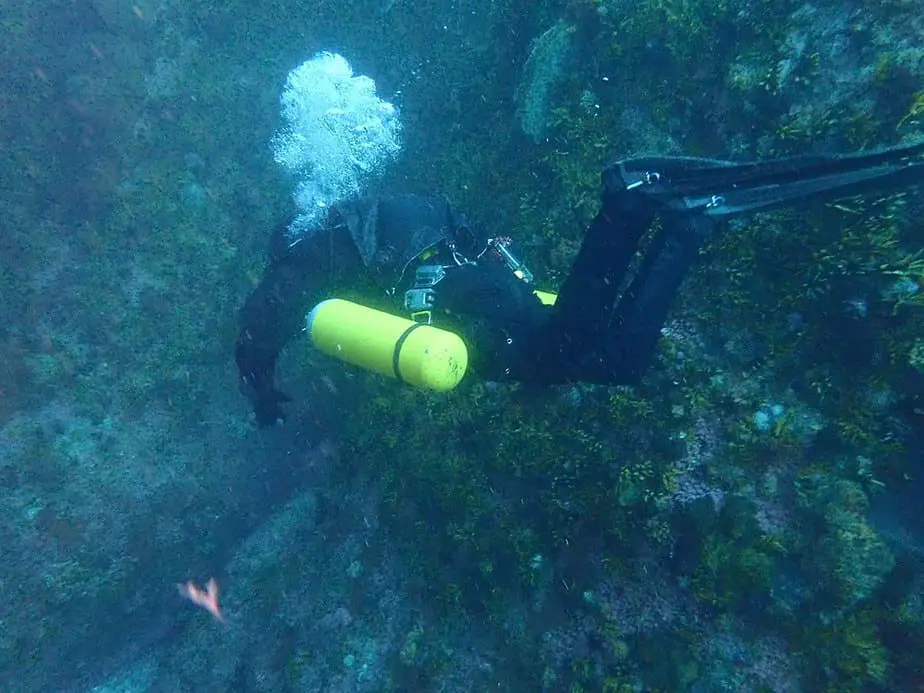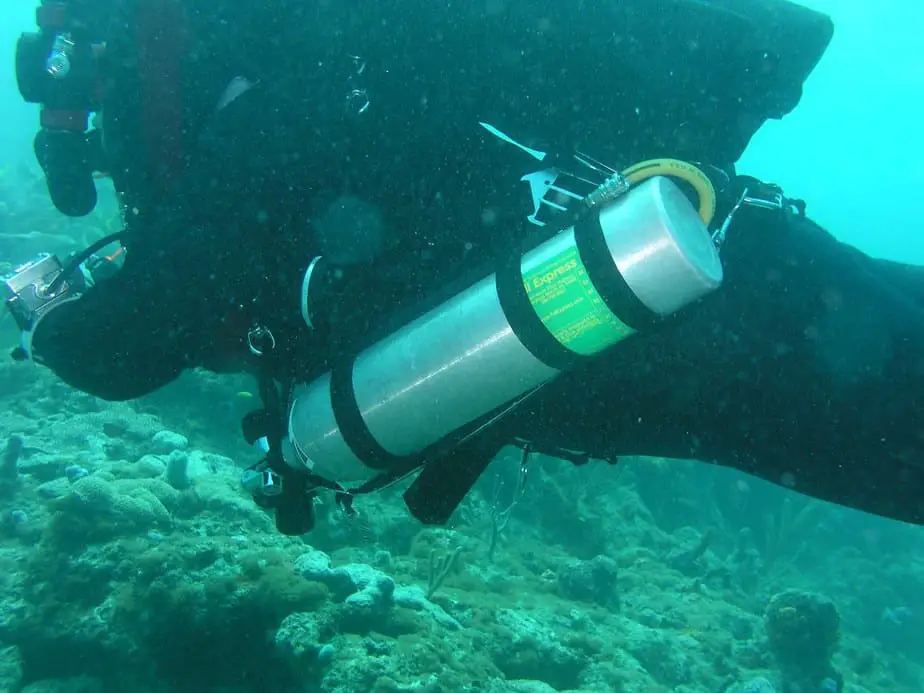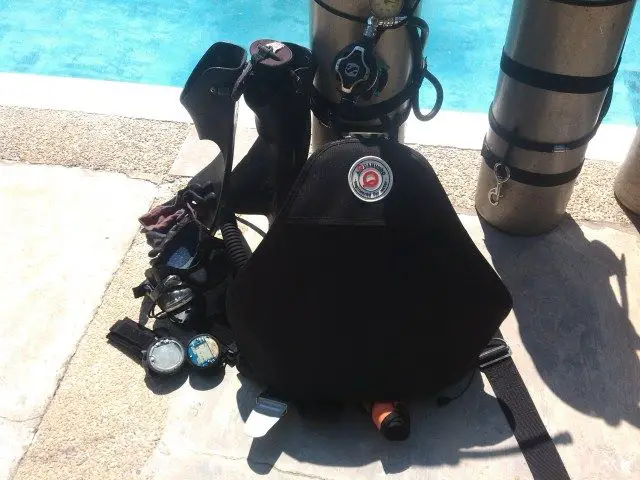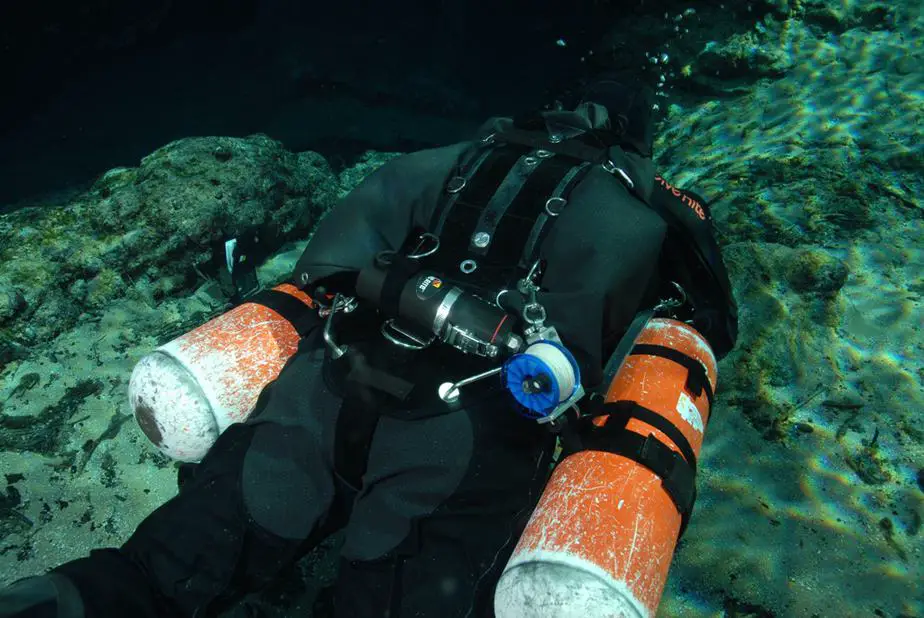Sidemount diving is a way for a properly trained diver to improve his/her trim, air consumption, and buoyancy. It also allows some older divers or people with back pain to use a different configuration where they don’t need to walk around with two heavy tanks strapped to their back. The positioning of the valves in a sidemount setup allows for convenient access, and managing gas becomes much safer because of this.
The beauty of sidemount is that you don’t even need two tanks. You can sidemount with a single tank, or multiple tanks for technical diving. For many divers, sidemount goes beyond just changing the configuration of their equipment. It is a philosophy for diving, one where the goal is to streamline themselves as much as possible by bringing only the gear that is necessary. This helps divers fit through small passages and reduces the chance of getting tangled up.
What began as a tool for cave exploration and sump has grown in popularity over the years. Now, the sidemount configuration is used worldwide by divers of all types and backgrounds. Unfortunately, there are many misconceptions about what sidemount diving is. In this article, we will go over the numerous benefits of sidemount diving, why you should do it, and how you can get started.
Sidemount Diving Benefits
Greater gas capacity
One major advantage that a sidemount configuration provides is an increased gas capacity. Assuming you’re carrying two tanks, then you have double the amount of gas which can be beneficial in many situations.
Obviously, having double the amount of gas, you can have at least double the bottom time. When diving with nitrox, you can get even greater dive times by increasing your no-decompression limit (NDL). It’s not unusual for recreational sidemount divers to have dives lasting longer than 120 minutes. For most recreational divers, their dive time is only 40-60 minutes; doubling that would be a dream for them.
Second, for divers who have a high breathing rate which causes their dives to end faster than they expect, switching to sidemount is an obvious solution.
Third, the increased gas capacity can save you or your buddy’s life in an emergency situation. For deeper recreational diving, the added gas tank is a reassuring safety buffer which can prevent out-of-gas situations and accidental decompression incidents. Sharing gas becomes much less stressful due to the abundant capacity.
By incorporating sidemount with nitrox diving, recreational divers can drastically improve their bottom times while staying within their NDL. This is a good stepping stone for divers looking to improve their diving experience without fully transitioning into technical diving.
Streamlining
The shape of our body is not ideal for the underwater world. Not only do we not have gills and have a lower tolerance to pressure, but compared to the dolphin or seal for example, we are unstreamlined in the water. For deeper dives, particularly technical dives, this has a severe consequence.
Divers are always trying to reduce drag, and great consideration is put toward streamlining our configuration. Otherwise, drag will slow us down and force us to use more effort to achieve effective propulsion. Furthermore, increased physical exertion leads to an increased breathing rate. This causes a double whammy of depleting your gas quicker and results in faster carbon dioxide build-up which increases the risk of oxygen toxicity and nitrogen narcosis.
Even though those are extreme situations that are unlikely to occur, it is still worth factoring the risk in when you are still optimizing your diving configuration. The aforementioned risks are increased if you are diving in strong current or strong flow environments where you are forced to kick harder and exert yourself more.
By using a sidemount setup, you are keeping drag to a minimum. With the tanks aligned to your side, you will have the minimum amount of surface area possible which makes propulsion easier and reduces the rate of breathing from the decreased exertion. This is crucial fin environments where constant, sustained propulsion is needed.
Redundancy
Redundancy is a great benefit for all divers, technical and recreational alike. Diving in sidemount gives you unparalleled redundancy; instead of relying on a mini-scuba tank, how about having another regular-sized tank? With two separate tanks, you get two separate first and second stage regulators, putting you one step closer to being a self-sufficient diver.
Not only do you benefit from this, but your dive buddy as well. If they have something wrong with their gas tank, you have extra gas to share. The added redundancy is also great for deeper recreational diving. In the event of a gas tank malfunction then you have a spare to make it to the surface without needing a buddy to share their gas.
Stability and trim

It wouldn’t be right to say that good stability and trim is not achievable in a backmount configuration; thousands of divers successfully dive in backmount everyday. However, one can make the argument that it’s easier to achieve perfect trim when diving in sidemount. As a result of the tank positioning on our lateral plane, we have a much easier time achieving balance and stability, letting us adopt a more horizontal position.
Assuming both tanks are the same, then we can naturally stay horizontal and level on all planes. In other words, we can swim at 90 degrees on our side, normally, or even upside down; in all cases, we will remain stable.
Compare this setup to a twinset. Although it’s obviously possible and relatively straightforward to achieve, a diver’s centre of gravity is higher in a twinset and therefore more susceptible to changes on the lateral plane. For instance, if a diver in a twinset were to lean to one side, the weight of the twinset will cause him to turn fully upside down unless he resists it.
In other words, backmount configurations require more bodily tension to maintain stability and in trim which requires more energy and focus overall.
Versatility
Sidemount gives divers more choices for how they wish to enter and exit the water. If you have a physical disability that makes it difficult to enter the water with your tanks, sidemount gives you the option of donning and doffing your tanks whilst in the water. This opens up a new possibility for those who would otherwise struggle with the equipment on land.
For example, if you have a back condition like multiple sclerosis or other major back problem due to injury, you continue to dive by using a sidemount configuration. Sidemount gives people with physical disabilities the opportunity to continue their diving education. If you have a back injury and want to enroll in an entry level technical diving course, you won’t be forced to endure the weight of a twinset.
In a similar vein, people with a smaller stature or those who struggle to lift the heavy weight of a twinset can also benefit greatly from sidemount. In this respect, sidemount is like a door that opens up the way to many possibilities in the world of diving.
Convenient valve access
Cold water and technical diving will benefit greatly from the ease of valve access in a sidemount configuration. Recreational divers can take advantage of it too. With the tanks in sidemount, you can see the first stage and access the handwheel of the valve. With a twinset configuration, you cannot see the first stages and you must reach behind you (requiring a gymnast’s flexibility and assuming you aren’t restricted by your wetsuit) just to open and close the valves.
The ability to conveniently open and close your tanks while underwater is a boon for technical and cold water diving. Even recreational divers will notice an improvement in their safety such as in the case of a free-flowing regulator. Having convenient valve access allows you to quickly reach and close the valves before you run out of gas.
Divers using a twinset configuration struggle to access and close the valves on their tanks even if they are aware of a free-flowing regulator. Depending on your shoulder size and health, you may not have the flexibility to do so especially if you’re an older diver or have a lot of muscle mass. It’s not good to exacerbate a bad shoulder, and you shouldn’t feel pain just to reach some valves.
By switching to sidemount, this simple change can possibly save your life in an emergency. Having easy access to the first stage and valves lets you solve problems before they can get worse. For instance, you will be the first to know if a valve connection or first stage is leaking without having a buddy let you know. You’ll be a self-sufficient and safer diver overall.
Weight reduction

As we mentioned, switching to sidemount will reduce the weight and bulk of your scuba setup making it more suitable for the traveling diver. Sidemount harnesses tend to be lightweight and minimal in design, often able to be folded into very small sizes. Compared to a BP/W or jacket BCD setup, they will feel like you’re carrying around a boulder.
Underwater photography and videography
If you like to take your camera with you to capture the awe-inspiring experiences for posterity, sidemount can make your life easier. Since your back is freed up in this configuration, your spine is free to move, allowing for more mobility and flexibility. Combined with the increased stability sidemount provides, it’s easier to get into the optimal position to take the perfect shot.
Furthermore, sidemount divers gain more headroom, letting you maneuver yourself to get around any obstructions. Another advantage of the increased stability is that maintaining a horizontal position is easier, which lets you focus on your subject more easily. Combine all of these advantages, and it means that you have a greater chance of getting the perfect shot of rare wildlife without spooking them.
Additionally, if you need to access tight spaces to get a specific angle or focus on a rare critter, then you have the option of removing a tank, or even going no-mount, just to get into a tight space. With any other configuration, it would be impossible to get past a tight space.
The only real drawback of sidemount for underwater camera work is that the increased gas management from having to switch regulators throughout the dive, combined with stowing the camera when not in use (since the chest area is inaccessible in sidemount) can be quite headache inducing. However, these issues can be avoided with some planning as is done by many sidemount photographers daily.
Access specific environments
The sidemount configuration was originally created so that divers can fit through narrow spaces, particularly for cave diving and sump diving. It was a means to an end; a tool with minimal overhead so that divers won’t get stuck in tight-squeeze environments and can easily look above them. Lastly, in extreme cases, you have the option of fully removing all your tanks and the wing bladder.
Therefore, if you have an interest in specialty dives where getting trapped is a serious issue such as wreck or cave diving, then sidemount is the best configuration for the job. Once you experience the freedom and bliss of sidemount, you’ll not want to go back to any other configuration.
A taste of technical diving
Divers who are continuously advancing their skills over the years will find that sidemount diving is a natural path that leads to technical diving. For some divers, learning sidemount helped them realize that they actually love diving and want to pursue technical diving. Others realize that single tank, recreational diving has a charm in its simplicity. Either way, the diver benefits: they can head towards technical diving, or become a more versatile diver that can dive in sidemount if they want.
You can consider the sidemount course to be a taster for technical diving. There are some similarities in what you’ll learn. For example, you’ll be introduced to diving with multiple tanks, learn about the long-hose and long-hose gas sharing, and more skills with an emphasis on propulsion and trim techniques.
In short, the sidemount course may be the first time a recreational diver is introduced to completely new equipment and a different configuration. By the time a diver is qualified enough to enroll in a sidemount course, it’s usually at a critical juncture where they realize they want to take diving to the next level or they are content where they are.
We know of divers who, after taking the sidemount course, found that their passion for diving has only grown stronger, and now they have their eyes set on technical diving. Even if you take the course and realize sidemount (and technical diving) is not for you, at least you’ll come out with more knowledge of diving and your skills as a diver.
Should I take a sidemount diving course?
Nowadays, with the availability of YouTube videos and various scuba diving websites (not unlike this one), you can probably learn a great deal about sidemounting on your own. However, there’s only so much that can be taught in a one-sided manner.
It’s important that the instructor teaches you the nuances first hand. The instructor can also give you real-time feedback, help you make adjustments, and answer any questions you may have. If you are learning on your own, it’s very easy to make a mistake, not catch it, and turn it into a bad habit that’s hard to unlearn later on.

Photo Credits: Matthew Hoelscher (CC BY-SA 2.0)
You’ve relied on an instructor affiliated with a training agency to teach you other aspects of scuba diving thus far, correct? So you should continue your education under their guidance. Most scuba diving training agencies, e.g., TDI, SDI, SSI, PSAI, LANTD, and even PADI has sidemount training courses.
Some are good, but admittedly, some are absolutely atrocious. In the next section, we’ll teach you how to find a good sidemount diving instructor so you can get it done right the first time.
Finding the right sidemount instructor
Unfortunately, sidemount sometimes gets a bad rap because of poorly informed instructors spreading misconception or misinformation. At one point, when sidemount diving was suddenly thrust into the spotlight, many instructors were needed to deal with the demand. This resulted in the certification of many instructors whose knowledge of sidemount was barely any better than the average diver.
As a result, there were many groups of divers that were “led astray” so to speak by their instructor, resulting in the rise of numerous unskilled sidemount divers and a bad reputation for sidemount diving in general. The sentiment was that sidemount was too complicated for recreational divers, it was inconvenient to use on a boat, and pointless for open water diving, so on and so forth.
These insults were, both fortunately and unfortunately, the result of ignorance or from bitter divers who saw little to no benefits from their inadequate training. The point is that finding the right instructor is crucial to your success as a sidemount diver and even as a technical diver. Remember how we said this is a stepping stone? The knowledge you gain here can bridge the gap between recreational and technical diving.
So how can you find a good instructor? There are some basic things to look out for and questions to ask when shopping around for a sidemount instructor.
Ask: How much experience do you have with diving in a sidemount configuration?
This is a straightforward but crucial question. Unfortunately, the requirements to be a sidemount instructor is laughably low. To qualify, the sidemount instructor only needs a handful of dives in sidemount configuration, or even just a recommendation from an Instructor Trainer, and they can be certified.
As you can see, having adequate experience is not a requirement. Therefore, since you cannot be certain that the dive center is strict with their hiring process, it’s also on you to find out your instructor’s diving background and sidemount diving experience. One does not need to have thousands of dives, however a solid base is to be expected.
If you have to choose between two sidemount instructors, a good measure of competence is if the instructor is trained to a higher level than the course they are teaching. For example, if one instructor is only qualified to teach recreational sidemount, but another has experience with cave diving or technical sidemount diving, then the safer bet is the latter option.
Furthermore, a diver with more experience can see how their teachings apply in a holistic manner. For instance, if they know how a sidemount configuration can change and adapt to more advanced environments such as caves or wrecks, then they can better prepare you for when you do take a cave or wreck diving course.
Overall, this will result in a deeper understanding of the lessons because the instructor, who can see the big picture, will explain the reasoning behind every little thing s/he teaches you and how it can benefit you now and in future courses. Next question:
Ask: How long will the course take?
Again, this question seems straightforward but has many implications. To preface this, the minimum course requirements is two days. However, we know that sometimes the minimums put forth by these training agencies is little too low. Especially given the specialist nature of sidemount diving, is two days really enough time to gain enough knowledge and experience?
Perhaps if your instructor is world class, and you are able to grasp everything that’s taught to you in record time, then 2 days might be sufficient. However, most people would probably need more time to receive a proper education. Even the most successful, top instructors allocate 4-5 days of time to properly train everyone. Some even emphasize that certification is not guaranteed, and if needed, they will even extend the course to give their students another chance. When the time limit is generous, it’s typically a sign of a caring instructor.
On the other hand, instructors who have a 100% pass rate or emphasize how quickly you can get certified raise a red flag. While in the short term, it seems like a great deal because you are basically purchasing your license instead of earning it, it also means you are not a safe and effective diver. The thing is, this is your life that you’re risking each dive; it’s not enough to be certified, you should also be competent. Plus, if you have to retake the course to receive the education you should have got initially, the outcome is you spent more time and money than you needed to.
Experienced sidemount instructors know the fine details of diving in a sidemount configuration and will spend time on the crucial components. They will not limit themselves to just two days, and will not move on if you don’t understand what’s being taught. Quick fixes and meeting the bare minimum requirements are a bad combination.
A follow-up question you can ask is how the course will be laid-out. For example, will there be half-day or day-long equipment theory workshops, ample time for shallow skills dives, fine-tuning configuration, emphasis on teaching the fundamentals and gaining the intuition to dive in sidemount, and so on. If the course instructor has a detailed plan, you can figure out whether that sounds reasonable or not.
Leverage the power of social media
If your prospective instructor or dive center has a social media page such as Facebook, Instagram or any other online presence, you can get a preview of what it’s like to take a course with them. See the conditions you’ll be diving in.
Notice also if the tanks worn by the students/instructor are in trim next to their body. Also, are they continuously horizontal in the water column? Are there weights strapped to the base of the tanks? (If so, that’s a red flag.) Even just a cursory glance at their pictures on their website or on social media can give you a lot of information about what you’re going to be working with.
Which is the best sidemount rig for me?

Now that you have an idea of why you should dive with a sidemount configuration, the next question is what kind of equipment do you need? For starters, you’ll need sidemount harnesses and wings. Some large scuba equipment manufacturers make them too, but some divers prefer to make their own rigs.
If you’re looking to purchase a rig, a few of the most notable commercially available systems are the XDeep (classic, tec, and rec variants), the Razor Harness, the Ultimate SM Harness, Hollis SMS50, Apeks WTX-25, and the UTD Z-System. These rigs are designed for sidemount and have stood the test of time. You can check out our review of the best ones here.
You can also use a rig that is not sidemount specific (but can be used for sidemount) such as the DiveRite Nomad (several variants) and the Hollis SMS75/100, just to name a couple.
What’s the benefit of getting a sidemount-specific rig? To start, most sidemount rigs use custom-sized harnesses and come with wings that only provide lift in specific areas where it is needed. There are no extra clips, rings, or unneeded parts, whereas multi-use rigs can be used for sidemount, single tank backmount or twinset.
Multi-purpose rigs also have larger wings and additional components that are not useful for sidemount which only adds more bulk and drag. You may find them too large or cumbersome for sidemount, particularly if you dive with aluminum tanks (which most tropical diving destinations will loan out).
There are various sidemount rigs out there, and it’s important that the instructor for the sidemount course is knowledgeable about the various systems. Hopefully they are not just advocating one particular brand of equipment or training system.
Parting words
In summary, sidemount diving is a great way for recreational divers to get a taste of technical diving. Some major advantages of sidemount are its ease of accessing the valves and regulators, better stability and trim, its streamlined profile, and its accessibility for divers with physical disabilities and back problems.
These are benefits that seem minor, but can actually make a difference between life and death. For instance, if you have a free-flowing regulator, in the sidemount setup you are in a better position to spot it and correct it. Even if one tank is compromised, you will have a spare tank which makes it a lot safer for you or your dive buddy to fall back on as a backup tank.
If you have any interest at all in sidemount diving, even if you are a recreational diver, you should consider enrolling in a course to find out if there’s more to this interest or not. If you do enroll in a course, take your time to find the right instructor. Shop around and don’t be afraid to ask them why they are qualified to teach you. Sidemount diving may become your next big passion and is a great stepping stone towards technical diving.
Photo Credits: Pete Nawrocky, CC BY-SA 3.0

